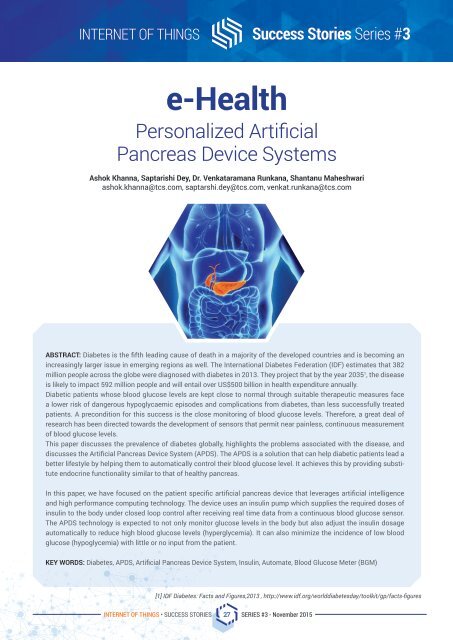Success Stories
VEZSJ
VEZSJ
You also want an ePaper? Increase the reach of your titles
YUMPU automatically turns print PDFs into web optimized ePapers that Google loves.
Internet of Things <strong>Success</strong> <strong>Stories</strong> Series #3<br />
e-Health<br />
Personalized Artificial<br />
Pancreas Device Systems<br />
Ashok Khanna, Saptarishi Dey, Dr. Venkataramana Runkana, Shantanu Maheshwari<br />
ashok.khanna@tcs.com, saptarshi.dey@tcs.com, venkat.runkana@tcs.com<br />
ABSTRACT: Diabetes is the fifth leading cause of death in a majority of the developed countries and is becoming an<br />
increasingly larger issue in emerging regions as well. The International Diabetes Federation (IDF) estimates that 382<br />
million people across the globe were diagnosed with diabetes in 2013. They project that by the year 2035 1 , the disease<br />
is likely to impact 592 million people and will entail over US$500 billion in health expenditure annually.<br />
Diabetic patients whose blood glucose levels are kept close to normal through suitable therapeutic measures face<br />
a lower risk of dangerous hypoglycaemic episodes and complications from diabetes, than less successfully treated<br />
patients. A precondition for this success is the close monitoring of blood glucose levels. Therefore, a great deal of<br />
research has been directed towards the development of sensors that permit near painless, continuous measurement<br />
of blood glucose levels.<br />
This paper discusses the prevalence of diabetes globally, highlights the problems associated with the disease, and<br />
discusses the Artificial Pancreas Device System (APDS). The APDS is a solution that can help diabetic patients lead a<br />
better lifestyle by helping them to automatically control their blood glucose level. It achieves this by providing substitute<br />
endocrine functionality similar to that of healthy pancreas.<br />
In this paper, we have focused on the patient specific artificial pancreas device that leverages artificial intelligence<br />
and high performance computing technology. The device uses an insulin pump which supplies the required doses of<br />
insulin to the body under closed loop control after receiving real time data from a continuous blood glucose sensor.<br />
The APDS technology is expected to not only monitor glucose levels in the body but also adjust the insulin dosage<br />
automatically to reduce high blood glucose levels (hyperglycemia). It can also minimize the incidence of low blood<br />
glucose (hypoglycemia) with little or no input from the patient.<br />
KEY WORDS: Diabetes, APDS, Artificial Pancreas Device System, Insulin, Automate, Blood Glucose Meter (BGM)<br />
[1] IDF Diabetes: Facts and Figures,2013 , http://www.idf.org/worlddiabetesday/toolkit/gp/facts-figures<br />
Internet of Things • <strong>Success</strong> <strong>Stories</strong> 27 SERIES #3 - November 2015









